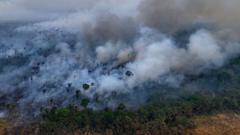In 2024, tropical forests lost an alarming 67,000 square kilometers, driven largely by fires exacerbated by droughts and climate factors. However, Southeast Asia shows progress through effective forest conservation policies, highlighting the need for consistent global efforts to mitigate deforestation.**
Unprecedented Tropical Forest Loss Threatens Global Climate Stability**

Unprecedented Tropical Forest Loss Threatens Global Climate Stability**
New satellite data reveals record rates of tropical forest destruction, particularly in the Amazon, due to extreme fires and climate change.**
The world's vital tropical forests have been devastated at an unprecedented pace, according to the latest satellite analysis, revealing a loss of about 67,000 square kilometers (26,000 square miles) in 2024. This staggering figure equates to an area almost the size of the Republic of Ireland, representing a dire reality as nature’s climate safeguard is eroded at an alarming rate.
Fires emerged as the primary driver of this destruction, surpassing agricultural land clearances for the first time in recorded history. The Amazon rainforest was particularly hard hit, suffering from the worst drought conditions on record, exacerbated by climate change and a natural warming El Niño weather pattern. These factors contributed to an amplifying cycle, where the intensity and frequency of fires increased significantly.
Experts express grave concern regarding the resilience of critical ecosystems such as the Amazon, warning that they could be nearing a “tipping point.” Professor Matthew Hansen, co-director of the GLAD lab at Maryland University, describes the situation as alarming, indicating that the potential for "savannisation," where vibrant tropical rainforests fade into unproductive savanna landscapes, is becoming more plausible based on current trends.
Recent studies indicate that if global warming exceeds the international target of 1.5°C, it could lead to catastrophic diebacks in the Amazon rainforest, jeopardizing countless species and posing serious risks to global climate health. The Amazon has traditionally absorbed more carbon dioxide than it releases, a balance now threatened by the extensive forest fires, which emit enormous amounts of CO2, intensifying global warming.
In 2023-2024, the Amazon's drought conditions fueled unprecedented fire spread, with Brazil and Bolivia experiencing severe impacts. The year marks a pivotal shift where the clearing of land for agriculture is no longer the sole catalyst for deforestation; intense fires driven by climate change have become a major threat, complicating the issue of ecosystem preservation.
Amidst this troubling trend, there is a glimmer of hope reported in Southeast Asia, where concerted governmental efforts have resulted in an 11% reduction in primary forest loss in Indonesia, despite adverse weather conditions. These advancements stem from strong enforcement of "no burning" laws and active participation from local communities. Elizabeth Goldman from the Global Forest Watch highlights that political commitment is crucial for the success of such environmental protection initiatives.
While the reported progress in Southeast Asia is promising, the fluctuating rates of forest loss in Brazil underscore the necessity of maintaining consistent protective policies. Hansen stress the importance of continuous efforts to conserve ecosystems, emphasizing that effective forest management cannot be a sporadic endeavor.
As the world eyes the upcoming UN climate summit COP30, set to take place in the Amazon, there is an opportunity to promote and bolster forest conservation strategies. Proposals are being discussed to reward countries for maintaining their tropical forests, addressing the economic disparity where immediate profits are often prioritized over long-term ecological health.
This year's data serves as a critical reminder of the ongoing battle against climate change and the need for innovative solutions geared towards climate resilience and sustainable forest management.




















